The following comes from A History of Lavaca County by Paul C. Boethel:
Antioch, also known as Karney's, was a village in the southeast portion of the county between Clark's Creek and Supple Jack. In 1881, it was a flourishing town with three general merchandise stores, a drug store, a saloon, a blacksmith shop, gin, and mill. Later a part of its business enterprises moved three miles north to Koerth, and with the coming of the railroad, a portion moved to Sweet Home. In 1887 Charles Karney & Son was the sole business firm and operated a gin and mill.
Antioch (Creole)
On July 20, 1872 Andrew Tidwell donated two acres of land to the deacons of Antioch Baptist Church and to the school trustees for the purpose of building a church and school building. Antioch is located 1 mile west of County Road 1 on land currently owned by Salem Baptist Church. The property is bordered on the north by the Roden/Zeller propertry and to the south by Otto Borchers. In the October 29, 1892 issue of the Tribune Herald there is mention of the chair factory at Antioch blowing up. The factory was owned by Roden and Brown. Later the name changed to Creole or Creola and the Creola school operated until 1915 or 1916. A Mr. Gardner had a store at Creole which housed the post office from 1903-1911.
Baursville
Historical Marker
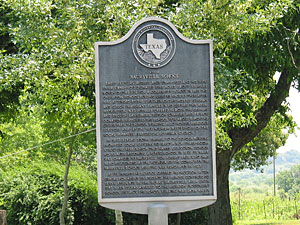
from Moulton, take FM 532 about 5 miles east to CR 261, then go north on CR 261 about .9 miles
|
Site of Baursville School
Early settlers August Baur (1841-1902) and his wife Emilie (1848-1901) donated five acres about 1.5 miles north of this site for a community school in 1881. A one-room school building was erected shortly thereafter. Because many students who first attended the school were members of German and Czech families who settled this area, instruction initially was offered in both the German and English languages. Tuition charges and private donations supported the school for about five months of the year. The school building was also the site of religious services held by the Rev. Wilhelm Westerhoff of Moulton's Immanuel Evangelical Lutheran Church. In 1892 severe storm damage to the school building prompted local citizens to erect a new three-room structure here which they named Concordia School No. 33. After becoming a public school in 1895, its name was changed to Baursville for August Baur who was also recognized as the founder of the community. The Baursville School building was renovated in 1927. At its height the school offered instruction in ten grades for about 95 students. The school continued to serve students in the rural Baursville area until 1951 when it was annexed to the Moulton Independent School District. The school building was later razed. 1994
|
Related Link
Baursville Cemetery
Boxville
The following comes from The Lavacans by Paul C. Boethel:
There was . . . a settlement about two or three miles north of Speaksville that had been on the Navidad in the 1840's by Marmaduke Box called Boxville; it had a store and a church and the county maintained a road to it. Charlie Herkimer was the last known storekeeper.
Bovine
In A History of Lavaca County, Paul Boethel writes: "Bovine, a village that developed and passed with the cattle drives, was located on Brushy Creek. In 1875 it had an excellent stone church and several stores."
Breslau
Breslau is on Farm Road 957 seven miles northwest of Hallettsville in north central Lavaca County. In the early days of the Republic of Texas, James Lyons received a headright certificate and located a one-half league tract there on the east side of the Lavaca River. Between 1845 and 1848 the Lyons tract became the property of Walter Hinkley, a prosperous lawyer and planter from Harrison County, who occupied the area and in 1850 purchased the tract granted to Horace Eggleston on the west side of the river. The Hinkley plantation was relatively self-sufficient and was worked by the second largest force of slaves in Lavaca County. Following Hinkley's death in 1854, the plantation remained in the ownership of his widow until much of it was sold by a subsequent husband to pay debts.
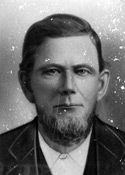 During and after the Civil War German immigrants moved into the area and established small farms to grow cotton. In the 1870s Fritz Ladewig acquired the land surrounding the old Hinkley crossing on the Lavaca River, established a store and cotton gin, and donated land for a school and a Lutheran church. The community, named in honor of the Prussian city of Breslau (now Wroclaw, Poland), prospered, and in 1880 a post office was established. Although the post office closed in 1911, the predominantly Protestant German community remained relatively self-sufficient during the opening years of the twentieth century. By 1915 enough Czech Catholic immigrants had arrived to support a church of their own. The economy of Breslau rose and fell with the supply and demand for cotton. By 1948 the community had six stores, two schools, a gin, a community hall, and a population of about seventy-five. Subsequent school consolidation sent the students to Hallettsville or Schulenburg. The discovery of oil and the decline of cotton production caused the gin and most of the small businesses to close during the 1950s and 1960s. Most of the farmland reverted to range for cattle, and, although in 1987 two stores remained, the sixty-five residents conducted most of their business in Hallettsville. In 1990 the population was still sixty-five.
During and after the Civil War German immigrants moved into the area and established small farms to grow cotton. In the 1870s Fritz Ladewig acquired the land surrounding the old Hinkley crossing on the Lavaca River, established a store and cotton gin, and donated land for a school and a Lutheran church. The community, named in honor of the Prussian city of Breslau (now Wroclaw, Poland), prospered, and in 1880 a post office was established. Although the post office closed in 1911, the predominantly Protestant German community remained relatively self-sufficient during the opening years of the twentieth century. By 1915 enough Czech Catholic immigrants had arrived to support a church of their own. The economy of Breslau rose and fell with the supply and demand for cotton. By 1948 the community had six stores, two schools, a gin, a community hall, and a population of about seventy-five. Subsequent school consolidation sent the students to Hallettsville or Schulenburg. The discovery of oil and the decline of cotton production caused the gin and most of the small businesses to close during the 1950s and 1960s. Most of the farmland reverted to range for cattle, and, although in 1987 two stores remained, the sixty-five residents conducted most of their business in Hallettsville. In 1990 the population was still sixty-five.
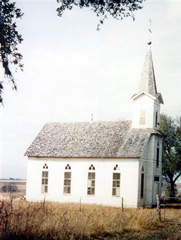 Sally Fahrenthold contributed this 1961 photo that shows the Immanuel German Evangelical Lutheran Church built in 1913, that once stood next to the Breslau Cemetery. Services were discontinued in 1957. The photograph of Fritz Ladewig was contributed by Rox Ann Johnson.
Sally Fahrenthold contributed this 1961 photo that shows the Immanuel German Evangelical Lutheran Church built in 1913, that once stood next to the Breslau Cemetery. Services were discontinued in 1957. The photograph of Fritz Ladewig was contributed by Rox Ann Johnson.
Text from the historical marker on FM 957 at Breslau:
Site of Breslau School
>
German and Czech immigrants moved to this area in the 1860s and 1870s and established small farms to grow cotton. Their community, named Breslau in honor of the Prussian city of Breslau, was located on the east side of the Lavaca River. Fritz Ladewig established a store and cotton gin in the 1870s, and in 1872 donated land for a school. In 1887, the school building was converted to a teacherage and a larger schoolhouse was erected.
The community of Breslau prospered, and in 1880 a post office was established. Henry Weller donated an acre of land for a school for African American residents and a schoolhouse was built.
After 1900 Breslau included stores, a blacksmith, dance hall, school and Lutheran and Catholic churches. Private donations supported the school until 1910 when a school tax of seven cents was levied and additional classrooms were constructed. A teacherage was built in 1919, and in 1922 Wessel Buss sold three acres of land on which a modern school building was built. The African American school closed in 1955. The Breslau School provided quality education for the community until June 1963 when the school was closed and consolidated with Halletsville schools. (1997)
Breslau Gun Club

Breslau Gun Club, 1888
Standing: Jim Vollentine, Herman Sauer, Tom Tucker, Reinhard Breyer, Albert Mueller, Charles Muecke, Jr., Humphrey, Joe Albrecht, Albert Sauer, Fritz Albrecht, Henry Rickewya
Seated: Frank Brown, W. H. Striebeck, William Helwig, Henry Striebeck, Herman Ummelman, Charles Muecke, Sr., Adolph Zappe
The Breslau gun club later merged with the Appelt's Hill club. Please contact Theresa Voelkel, who contributed this photo, if you have a clear copy of this photograph.
Related Links
Breslau Cemetery
Breslau Negro Cemetery
Ezzell
Ezzell is on Farm Road 531 ten miles south of Hallettsville and two miles north of the Lavaca River in southern Lavaca County. It is the oldest settled area in the county. Families from Stephen F. Austin's colony settled at the site between 1830 and 1836 and traded at Petersburg, the old county seat, six miles to the north, until Sam and Ira Ezzell started a store during the Civil War. A private school taught by literate slaves operated at Ezzell. After the war, school was held in church buildings until 1883. In 1980 Ezzell had a population of fifty-five, a church, a school, and no businesses. The population was still reported as fifty-five in 1990.
In A History of Lavaca County, Paul C. Boethel adds the following: Ezzell, in the heart of the country called "Tiger Bend," is located fourteen miles below Hallettsville near the Lavaca River; in the early days of the county's history, it was known as Kent. In 188, it had two general mercantile stores, A. B. Noble and W. C. Noble, and a gin and mill owned and operated by L. P. Jones."

Live Oak School, 1896
The teacher who is standing in the middle holding a book is Inez Scallorn Jacobs (she married Edward Jacobs in 1898).
Standing on Inez's right is her sister, Maude Scallorn Harless, and on Inez's left is her sister, Mable Scallorn Brown.
The Live Oak School was eventually absorbed into the Ezzell school district.
If you know more about this photo or Live Oak School, please contact Janet Jacobs Absher who contributed the photo.
Click on the photo to see a larger view.
Gleckler
Gleckler (Glecklar) is a decentralized farming community on U.S. Highway 77 about five miles south of Schulenburg and fifteen miles north of Hallettsville in northern Lavaca County. In 1831 William P. Hensley, a member of Green DeWitt's Gonzales colony, received land in the area from the Mexican government. This grant straddled the old road from San Felipe to San Antonio and, during the retreat of the Texas army from Gonzales in 1836, was crossed by both the Texans and the Mexican army. As early as 1842 Gleckler's store, on the old road, was a regular stop and horse-changing station for the mail and passenger coach between Houston and San Antonio. After 1845 many German immigrants moved to the area and replaced most of the earlier Anglo-American colonists. The new settlers broke the large grants into smaller farms for the production of cotton rather than cattle. In 1874 the Galveston, Harrisburg and San Antonio Railway reached a point about five miles north of Gleckler and established Schulenburg. Although the store remained at Gleckler, most other businesses moved to the new town. From 1885 to 1905 a post office operated at the Gleckler store. In the early 1890s the community reported a population of twenty, and A. Gleckler served as postmaster and ran the general store. The community's population dropped to thirteen by 1896. By 1948 the town had two stores and a population of eighteen. After 1950 most of the cotton land reverted to pasture, and the most productive sites were planted in corn. When the local school was closed, most students went to classes in Hallettsville, although many Catholic students attended church schools in Schulenburg. In 1987 three businesses remained in the area.
Paul Boethel writes in A History of Lavaca County: "[Gleckler] was located on one of the oldest sections of the county; nearby was the old Thomas Chaudoin place, one of the first settlements in the county."
Good Hope
Good Hope is on U.S. Highway 90-A and Farm roads 133, 135 and 137, three miles east of Hallettsville in eastern Lavaca County. The area was originally patented to John Hallett. The community was just north of "the thicket," a name applied locally to the tangled vegetation found along the Lavaca and Navidad riverbottoms, where outlaws hid during the Civil War. The original population was freedmen, and the community remained predominantly black. By 1883 the Good Hope Missionary Baptist Church had become the focal point for community activities. Shortly thereafter, the San Antonio and Aransas Pass Railway connected Eagle Lake and Hallettsville and bisected the community. Residents worked for the railroad, as wood cutters, and as farm and ranch hands. In the 1950s the highway was improved, and travel to Hallettsville became easier. The railroad was removed soon afterwards. In the 1980s the church was still active, but residents conducted most of their business in Hallettsville.
Hackberry
See Hackberry history, photograph, and related links
Hallettsville
See Hallettsville history, historical markers, photographs, and related links
Henkhaus
Henkhaus is on the Southern Pacific line a mile west of State Highway 95 between Shiner and Moulton in western Lavaca County. During the Republic of Texas era, Henry Russell received a first-class certificate to lands along Ponton Creek and the old Columbus-Gonzales road. The gently rolling terrain and the loam and clay soils were well-suited for pasture and for many years provided excellent range for cattle. After the Civil War, German immigrants began to replace the earlier Anglo-American settlers, and the rangeland was broken into smaller farms. In 1887 the San Antonio and Aransas Pass Railway completed its line from Moulton to Shiner, and John Henkhaus built a store and cotton gin on the railroad on the old Russell land grant. A post office was established in the store in 1898 and continued to operate until 1907. The community's prosperity varied with the rise and fall of cotton prices. By 1950 improved travel conditions encouraged local residents to conduct business in nearby Shiner and Moulton, and only two businesses remained in Henkhaus to serve a population of about fifty. School consolidation at that time sent students to Moulton, and the local gin closed because of falling cotton prices. Some of the area farmland reverted to pasture, and other land was turned from cotton to grain production. In 1987 no businesses were reported at the community, but Henkhaus still had sixty residents.
Related Link
Otto C. Henkhaus
Hope
Hope, at the intersection of State Highway 111 and U.S. Highway 77, six miles from Yoakum in southwestern Lavaca County, was named for Hope's trading post. The community was established before the Texas Revolution and is located in Precinct Four, the only dry area in the county. The town reached its height in population just before the Civil War. During the war 100 volunteers from Hope enlisted in the Confederate Army, but only seven returned. A Methodist church was started in 1845 in a log hut on Scarbrough's Branch with twenty-three German founding members. It was moved to a two-acre site on Clark's Creek donated by Christopher Hornberg in 1856; worship services were in German. Charles Martin Hornberg, a son of Christopher, was an ordained minister and served the church at one time. This Methodist church was established in Hope in 1889 with a membership of about 100; at that time it was the only church in the community. The Shiloh Baptist Church, established in 1885, was consolidated with the Mount Herman church; a building was erected at Hope in 1896, after which the church adopted the name of the town and became Hope Baptist Church.
Hope's post office and its first schoolhouse were both built in 1857; the post office closed in 1906. The schoolhouse was constructed of logs and had high steps to keep wild hogs, common in the area before 1900, out of the building. A schoolhouse built in 1902 had been out of use for several years by 1987. In 1948 Hope had a store, a school, two churches, and a population of fifty. In 1986 it had two stores, two churches, and a reported population of ten. The two churches were both attended by people from nearby Yoakum. The remaining citizens of Hope had pooled their resources to purchase the old schoolhouse from the school district so that it could be restored and used as a community center. Another community center, a large white building owned in 1986 by Tom Brown, was used for country and western music performances the first Saturday of every month and for dominoes on the remaining Saturdays. In 1990 the population of Hope was recorded as forty-five.
Paul Boethel writes in A History of Lavaca County: "In 1887, it was a trading post for a considerable territory; it had two general merchandise stores, R. B. Thrift & Co., and keepers & Brocker. Also a steam mill and gin operated by D. C. Cook; a drug store operated by W. H. Kilgore with Dr. Thomas Presley, Jr., as physician. A school known as the Peoples' School was conducted there with J. N. McCain as principal, and it was well known for its extensive course of study."
Ronnie Lee (Scovel) Brothers contributed the following photo of the Hope United Methodist Church with the text of its historical marker:

Hope United Methodist Church
CR 413A
|
The United Methodist Church of Hope
German pioneers founded this church before 1845. It met in a log hut on Scarborough's Branch, had 23 members in 1850s, used German language in worship, and was in German missions circuit. Christoph and Christina Hornburg gave a 2-acre site on Clark's Creek in 1855, and the second log meeting house was erected. The present church was built in 1889 on newly-purchased site in Hope. By 1890, the membership reached about 100. The Sunday School was organized in 1892, and remains active. Up to 1894 this was the only church in Hope community. [Marker Erected in 1976]
|
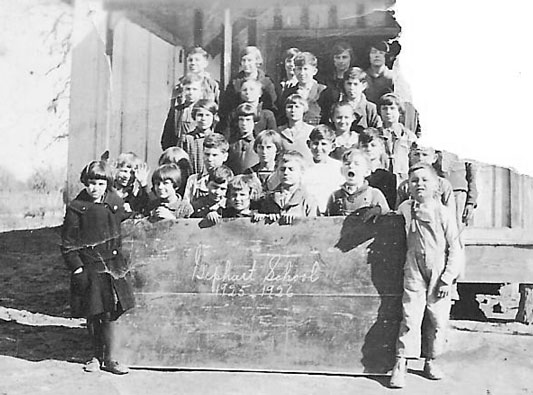
This photo of Gephart School pictures students during the 1925-1926 school year. Madeline Smith Wilkerson is among the students. Can you identify others? Photo contributed by Janet Jacobs Absher
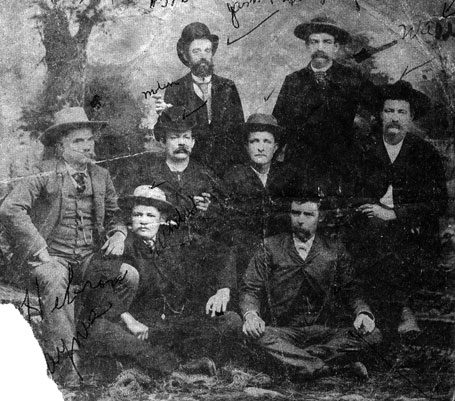
Susie Toal thinks these gentlemen were from Hope. Her grandfather was William Thomas Bishop. Please contact her if you recognize anyone.
Hopewell
The Hopewell Community was supposed to be four miles south of Sublime.

During and after the Civil War German immigrants moved into the area and established small farms to grow cotton. In the 1870s Fritz Ladewig acquired the land surrounding the old Hinkley crossing on the Lavaca River, established a store and cotton gin, and donated land for a school and a Lutheran church. The community, named in honor of the Prussian city of Breslau (now Wroclaw, Poland), prospered, and in 1880 a post office was established. Although the post office closed in 1911, the predominantly Protestant German community remained relatively self-sufficient during the opening years of the twentieth century. By 1915 enough Czech Catholic immigrants had arrived to support a church of their own. The economy of Breslau rose and fell with the supply and demand for cotton. By 1948 the community had six stores, two schools, a gin, a community hall, and a population of about seventy-five. Subsequent school consolidation sent the students to Hallettsville or Schulenburg. The discovery of oil and the decline of cotton production caused the gin and most of the small businesses to close during the 1950s and 1960s. Most of the farmland reverted to range for cattle, and, although in 1987 two stores remained, the sixty-five residents conducted most of their business in Hallettsville. In 1990 the population was still sixty-five.
Sally Fahrenthold contributed this 1961 photo that shows the Immanuel German Evangelical Lutheran Church built in 1913, that once stood next to the Breslau Cemetery. Services were discontinued in 1957. The photograph of Fritz Ladewig was contributed by Rox Ann Johnson.






